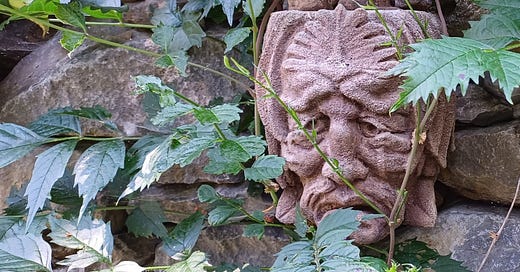And first a story…
Half my life ago, when I’d bought my first house, I’d no money for a garden. It was the golden age of Martha Stewart, and among her gardening hacks was to go to stone yards where they cut and polished tombstones. During the engraving, she swore, there would always be a few errors, and you could buy those botched headstones for cheap. You simply put the misspelled names or incorrect dates face down, and you had rich, polished granite or marble stepping stones. Maybe a whole patio. I suspect the engraving process has long-ago gone over to computers. Good luck finding such stones these days.
Another good hack was to go to cemeteries, particularity in the springtime. People will place pots of blooming bulbs on graves. When the daffodils, tulips, calla lilies, or whatnot wilt, the groundskeeper will dump all the pots into a pile to decompose. It’s an excellent way to get free flower bulbs, and I think I mentioned it in my novel Survivor.
By far my favorite garden hack came to me by accident. Friends and I were walking through a sales yard of concrete garden ornaments. The usual birdbaths and gnomes. Further back behind the sheds where they cast the stuff, I found a heap of headless statues and busted Corinthian columns. When Grecian urns got chipped, they went on this trash pile. The same went for cracked Florentine bric-a-brac. The chipped busts of Roman senators. It looked as if the Getty Museum had taken a shit.
I asked the owner how much he’d take for a busted urn, and he said, “I’m going to lunch. Give me twenty-five bucks for lunch, and you can have the whole pile.”
It cost more in gas, and trip after trip in my truck, to haul it all home. Much of it was so old it was already covered with moss and lichen. Some of it went into making a rock garden that looked like an archeological dig at Pompeii. The rest, I piled in the woods behind my house, where visitors would come across overgrown, broken columns and cornices and ask in hushed voices, “What used to be here?” Some were spooked, others charmed. The ruins spoke to them, confirming whatever they expected from the world.
This summer, the ruined castle I built during the lockdown is being overwhelmed by trumpet vine. See the photo above. In 2019, at the Barolo festival in Italy, I saw ancient stone walls and gates shaggy with this orange-flowering trumpet vine. Now my castle walls are getting buried in the same.
Which leads me to a friend…
One of my best friends from college visited recently. After graduating, he’d worked as an architect in Seattle and Los Angeles, and now he was renovating a house in the mountains of northeastern Oregon. Now he worked for the county’s planning department and spent his free time hauling garbage from the property he’d bought. A hoarder’s lifetime of junk stashed in sheds and stuffed in the crawlspace under the house itself. He told me, “What defeats me as an architect is just the constant entropy of it all.”
By this he meant the constant decay that attacks everything. The elements and living microbes are always at work. And not just the natural world. He explained how most of the ancient world — the marble statues and veneers of temples and tombs — was burned in bonfires to create powdered lime needed by farmers to sweeten the pH of their soil.
My friend said architects see very few of their projects actually get built. Clients love to pay for plans and moon over drawings, but very few pull the trigger and have their dream house built. Maybe because they sense it will never meet their expectations. Maybe because they suspect that the moment it’s built it will begin to fall apart.
This past December while I was in Los Angeles to record the Impact Theory podcast, Tom Bilyeu walked me through his house. A vast hotel-sized place at the crest of the Hollywood Hills. He said that with a house that big he’d had to hire a full-time fix-it person. A door hinge was always coming loose, or a security sensor sending a faulty signal. A writer friend told me about working with Dean Koontz in the latter’s almost-30,000-square-foot house, where a single man works full time washing the windows. As soon as the last window is washed, it’s time to go back and wash the first. That’s the man’s career.
Whenever I grumble over a dripping faucet, I think of Tom B’s house and Dean Koontz’s window washer. I think of entropy.
What strikes me is that entropy is my vocation. My job only starts when things begin to fall apart. As does yours.
Non-writers would say that the toughest job is solving the fictional problem at hand. To become a real writer you have to grasp the fact that creating the problem is infinitely more important that solving it. And infinitely more difficult.
If it helps, picture a book as a ruined building. A ghost town. Something left behind. The written words are artifacts, and it takes the reader’s imagination to animate them. A printed book is a dead thing. That’s the reason why I write longhand, because too often once words are typed and appear in 12-point New Times Roman, they look too finished and important to butcher with revisions.
And like a ruin, the best stories are the ones that trigger other people to tell their own stories. It’s entropy that creates the story. You create a problem and destroy a system or person. Be it Scarlett O’Hara’s Old South, or Randle Patrick McMurphy’s brain. And once it’s complete, printed, bound, and given a cover, it’s dead again. Only the reader’s mind can resurrect it. And I’d argue that verbs are your best tool to hook that mind.
Either the camera must move, or the subject must. For anything to hold attention it must change size and shape against the retina of the mind’s eye. Your reader is sitting still, and focused on the story, so the character must take action.
People stumble across these things covered with vines and moss. Headless statues and toppled columns. Troubling things. They demand a story for comfort. A lesson in how to evade entropy.
When those people asked — spooked by images of satanic rites, or charmed by the idea of midnight fairy rings — “What used to be here?” I’d shrug. I’d say, “Beats me. What do you think?” I’d ask, “Should I be worried?”
And their imaginations would be off and running.








You gave me a review of my piece a while back, the one about the guys robbing burial mounds with CB radio antennas. The reason that subject matter is so personal to me is because I’ve hunted arrowheads all my life with my dad. In the artifact world we have met such people who have and know how to rob graves (to be clear we never do that horrible thing and only surface hunt).
On to my point... Every time my dad and I go hunt arrowheads we often come back with bags full of broken pieces or flakes of flint and chert. I have bucket fulls that I fill in my garden. Ancient deer antlers and animal bones from long forgotten camp sites. I pile all of it around my house, mixing it in garden beds and pots. I like to think that one day long in the future someone will come across it all with confusion and dismay, wondering if they discovered an ancient site. I live surrounding my house with these sacred objects that were touched by human hands tens of thousands of years ago.
Has anybody said it yet? No? Alright:
“Fuck Martha Stewart.”